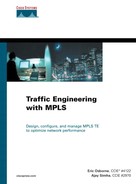Forwarding Traffic Down Tunnels with Policy-Based Routing
You can also use policy-based routing (PBR) to forward traffic down a tunnel. This is not a new feature; the capability to forward traffic down a particular interface has been in policy routing for a while.
Suppose that Src in Figure 5-1 has two types of traffic to send to Dst—voice traffic and data traffic. If you want to carry only voice traffic across Tunnel0, you can do so with PBR.
Figure 5-1. Example of PBR

PBR is enabled using policy route maps applied to the incoming interface. Under the route-map statement, simply match the voice traffic using the match statement and then use the set interface Tunnel0 directive to send traffic down Tunnel0. PBR has the advantage that you can send specific types of traffic down a tunnel interface without modifying a router's routing table. For example, voice traffic entering Router A in Figure 5-1 can be forwarded down the tunnel using PBR with no changes to the routing table on Router A. Suppose that Src in Figure 5-1 is connected to Router A over the Ethernet 0/0 interface. Further suppose that voice traffic can be identified as traffic that is destined to IP address 5.5.5.5 (typically a voice gateway). Example 5-1 shows the configuration that's required to achieve this.
Example 5-1. Policy-Routing Configuration on Router A
interface Ethernet0/0 ip policy route-map foo route-map foo match ip address 101 set interface Tunnel0 access-list 101 permit ip any host 5.5.5.5 |
As you can see, there's nothing special about policy routing into a tunnel interface; it works just like policy routing down any other interface. For more information on policy routing, see Appendix B,“CCO and Other References.”
